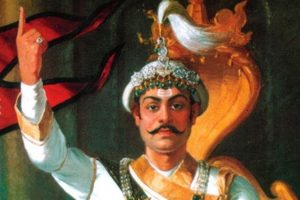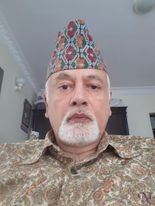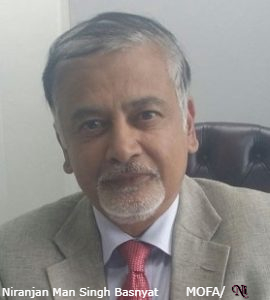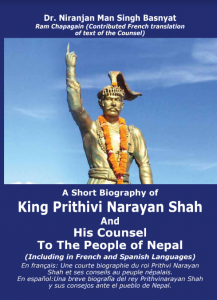Dr. Niranjan man Singh Basnyat.
Kathmandu, Nepal

The Chaubisi states in western Nepal became jealous of Gorkha because it captured prized locations, including the jewel of Kathmandu valley, which was the symbol of culture and wealth.
There is little doubt that the Gorkhali achievement was a major victory in the history of Nepal. All the trade to Lhasa was conducted from here. In September 1770, Kazi Kehar Singh Basnyat was sent by the King to the eastern region accompanied by Sardar Ramkrishna Kunwar with a view to further expand the territory under Gorkha.
In the meantime, Chaubisi States started creating trouble for Gorkha from its western frontier.
In view of Chaubisi uprising, the king sent Kehar Singh and Bansaraj Pandey with troops to these areas to quash the Chaubisi States in February 1770. Kehar Singh went toward Tanahun while Bansaraj Pandey went to Kaski. The king of Parbat Kirtibam Malla had convinced the kings of Pallo Nuwakot and Satahun to join together to stop Gorkha’s advance. Thus, Bansaraj could not succeed and returned to Shyangja.

On the other hand, troops under the command of Kazi Kehar Singh accompanied by Sardar Ranasur Pandey captured Tanahun on Monday 18 March 1771. When the king of Tanahun, Bikram Sen died, his eldest son Kumardatta Sen committed suicide. Since Kumardatta had no children, King Prithvi Narayan Shah agreed to make Kumardatta’s brother, Harkumardatta Sen, the king of Tanahun, as he had pledged to support Gorkhali forces. Thus, Tanahun soldiers were also incorporated into Gorkhali troops. After this, by the order of king, Kehar Singh went to attack Lamjung, a long time enemy of Gorkha, in April of 1771. The king of Lamjung Birmardan Shah could not face the Gorkhali advance and he surrendered. But Kehar Singh did not believe it was a complete surrender and took Crown Prince Birbhupal Shah to Kathmandu as collateral. Then with the consent of the King Prithvi Narayan Shah, Kehar Singh returned the territory of Raaginasgadhi, previously captured by Gorkha, to the king of Lamjung. King Birmardan Shah became very pleased with Kehar Singh Basnyat and awarded him with Shirpau (reward) and some land in Lamjung.
King Prithvi Narayan Shah also awarded him with some prize in view of his diplomatic skills and outstanding service to Gorkha.
Kehar Singh succeeded in annexing small principalities like Rising and Ghising without any bloodshed. But he had to fight to capture Bhirkot because the king of Parbat, Kirtibam Malla, had supported them. The king of Bhirkot could not face the Gorkhali attack and he fled to the other side of Kaligandaki River. As soldiers from Tanahun betrayed the Gorkhalis by not helping its troops as was previously promised during this battle, Kehar Singh executed ninety-six Tanahun soldiers on the spot. This episode had happened at the end of June 1771. Then, he went on to capture Garhun and Paiyun. He reached Shyangja and met with Kazi Banasaraj Pandey there.
It was the rainy season of 1771 when two military commanders, Kehar Singh Basnyat and Bansaraj Pandey, were living in Shyangja after establishing the barracks. On the other side, the Chaubisi were very angry about the loss of their 96 soldiers who were killed by Kehar Singh for betrayal. All Chaubisi were united to fight against the Gorkhali forces. An ally of king of Gorkha, King Harakumardatta Sen of Tanahun also sided with other Chaubisi states to fight against Gorkhalis because of the loss of his own troops.
In the meantime, Lamjung also joined forces against Gorkha. The prince of Lamjung fled from captivity in Kathmandu and came to Lamjung. The two Gorkhali commanders could not contact Kathmandu and no reinforcements from Kathmandu could arrive in time to help them.
However, Kehar Singh tried with his diplomatic skills to persuade Lamjung to take Gorkha’s side.
But the king of Lamjung was already emboldened by his son’s arrival from Kathmandu. The king of Parbat, Kirti Bom Malla, led the battle against Gorkha with the support from the forces of Lamjung and Tanahun. A fierce battle started on Monday 16 December 1771 in Satahun and Kehar Singh was killed with his 500 Gorkhali troops. Kazi Bansaraj Pandey was injured and captured by the enemies. Gorkha was defeated badly and lost a very talented military leader, Kehar Singh, who was instrumental in capturing so much of territories including the Kathmandu Valley for Gorkha’s conquest. (His wife Chitra Devi was the elder sister of Kazi Bansaraj Pandey and thus he was brother-in-law to Kazi Bansaraj Pandey).
Remaining Gorkhalis fled to Bhirkot and then to Dhor. Sardar Prabhu Malla and Sardar Ranasur Pandey were taken to Dhor and detained there by Chaubisi forces. They were besieged by enemies in Dhor for 14 days. The king of Dhor also sided with Chaubisi kings betraying Gorkha.
Knowing this, King Prithvi Narayan Shah sent some forces under the command of Dhaukal Singh Basnyat and Shreeharsha Panth to rescue. They reached up to Sati Ghat. At that time, besieged Gorkhali troops came by crossing the Marsyangdi River. But they had to return to Kathmandu after the loss of Gorkha. Those Gorkhalis who surrendered weapons to the enemy were dismissed and they had to pay Rs. 60 for each weapon they carried and another fine of Rs. 60 each. Other injured Gorkhali troops were captured by the enemy forces along with injured Kazi Bansaraj Pandey.
Bansaraj was put into custody in Beni. He was in detention there until 1775 and was only released after the death of King Prithvi Narayan Shah.
Thus, Kazi Kehar Singh, a talented military leader who had admirable administrative as well as diplomatic skills, was martyred in the battle like his father, Shivaram Singh, for the noble cause of unification. He had also solved the problem of jewelry of Seto (white) Machhindranath which was forcefully taken by a courtier of King Jaya Prakash Malla immediately after the capture of Kathmandu by Gorkhalis. Some Thakalis of the temple had protested about this incident to Gorkhalis. Kehar Singh Basnyat had resolved this problem by the orders of King Prithvi Narayan Shah.
Kehar Singh was like a son to King Prithvi Narayan Shah. The king and other Gorkhalis were shocked for several days when they heard news of his death. When Kehar Singh was killed, his sons Jahar Singh, Kirtiman Singh, and Bakhtabar Singh Basnyat were seven, four, and one years old, respectively. Later Jahar Singh Basnyat served as Kazi during King Rana Bahadur Shah’s reign and was engaged in battles against Sikkim, Tibet and China.
Kirtiman Singh Basnyat and Bakhtabar Singh Basnyat served as Mulkazi of Nepal.
Annexation of eastern Sen states:
Before the battle of Bhaktapur, Sworup Singh Karki and Harinandan Upadhyaya Pokharel of Kharpa, who were from Chaudandi, had already taken refuge under the protection of King Prithvi Narayan Shah in Nuwakot. A prominent Sardar Bangya Basnyat had given a positive report to the king for the attack in the eastern states of Sen Kings after his visit there. Abhiman Singh Basnyat was promoted to military commander as well as Kazi after the martyrdom of his brother Kazi Kehar Singh in 1772. The king sent him to capture the eastern part of Nepal. He went to Chaudandi and Bijayapur through Tarai.
Before that, the king thought that it was better first to capture Manjhkirat to make easier to capture Bijayapur. He had sent Bangya Basnyat to these areas to create a conducive environment for the local peoples to support the Gorkhali attack and already received his report. He also gathered some other information. After the return of Bangya Basnyat, the king sent Sardar Ramkrishna Kunwar and Amar Singh Thapa with troops. These two famous leaders captured all Majhkirat, including Rawagadhi, Halesi, Majhuwa, Kulam and other areas after crossing the Dudhkoshi River.
King Prithvi Narayan Shah wrote a letter in April 1773 to the Governor General of British In-
dia, Warren Hastings, asking him for his assistance in attacking Chaudandi and Bijayapur. In that letter, he had also requested Governor General not to help Buddhikarna Rai, Dewan of King Kamadatta Sen, as he had betrayed his own king and had captured by force the areas of Ambarpur and Bijayapur. The king promised to the British that he would offer some beautiful gifts and pay land revenue, if Nepali troops will be able to capture these areas with their cooperation. On the same date, Kazi Daljit Shah and Kazi Abhiman Singh also sent same types of letters to the British side.
The East India Company Government did not oppose Nepali troops because of these letters while attacking Chaudandi. Kazi Abhiman Singh and Sardar Partha Bhandari went with two companies of troops and attacked Ambarpur Chaudandi via Tarai (Talhatti) on Friday 16 July 1773. It was captured without any bloodshed. The king of Chaudandi, Karna Sen, had already fled to Bijayapur and his Dewan also fled with his troops. In Hanuman Nagar and adjoining areas, Kazi Abhiman Singh assured the local people not to be discouraged and continue to practice their day-to-day life as before in accordance with their own religious and social traditions with their properties and land intact. Nepali troops, he assured them, would not harm them or confiscate their property.
He also told them that before they were the subjects of Sen Kings and now they were under Shah King of Nepal. He sent messengers (Katuwals) all over the places to spread this message of King Prithvi Narayan Shah. After that, law and order was maintained in the newly annexed territories.
Kazi Abhiman Singh Basnyat convinced locally known persons Trilochan Pokharel and Harinanda Upadhyaya Pokharel while mounting an attack on Wollo Kirat across Koshi river. The
Pokharels were residents of Kharpa and Harinanda was a priest to King Karna Sen of Chaudandi before he defected to the Gorkhali side. With much persuasion, Kazi Abhiman Singh asked him to support King Prithvi Narayan Shah’s unification campaign. Harinanda Pokharel provided food and other logistics to Gorkhali troops led by Abhiman Singh. He also financed Rs.11, 051 (Rs. 3,585 for the salaries of soldiers and Rs. 7,466 at different times after the victory of Chaudandi), a huge sum at the time, for the Gorkhali campaign to capture Chaudandi and Bijayapur. But no one should forget that in return for the help, all their properties and lands were protected and maintained to Harinanda by Kazi Abhiman Singh. Besides this, Harinanda was promised additional land as well. This was revealed in a letter written on Saturday 26 February 1774 by Abhiman Singh and Partha Bhandari to Harinanda Pokharel from their base in Ambarpur. This was a testimony to the fact that Kazi Abhiman Singh possessed good leadership qualities required to convince people to side with
Nepalis.
The Solution of Sanyasi Problem:
After the capture of Ambarpur, Abhiman Singh was asked by the king to go to Mahottari to oppress Sanyasi looters at the request of the British Company Government. The fact of the matter was that these looters who came from Haridwar and Bengal used to loot the businesses (Kothis) of British businessmen in Dinajpur and Champaran on the other side of the border of Bijayapur. They used to take shelter in the forests of Nepal. They had also looted Nepali settlements very often.
They were giving a lot of trouble to the people of Tarai areas of Nepal. Abhiman Singh completely wiped out these Sanyasi looters by January 1774 and returned to Ambarpur. This was a major achievement on the part of Nepal which brought about a better relationship with the two countries.
The British were happy about it.
Annexation of Bijayapur:

After this episode of Sanyasis, King Prithvi Narayan Shah wrote a letter to Governor-General Warren Hastings of the East India Company about the fugitive Buddhi Karna Rai, who had fled to Bijayapur after looting and other illegal activities. But without expecting any response from the Governor-General, the king ordered Abhiman Singh to attack the Sen kingdom of Bijayapur (presently Sunsari and Morang). In June 1773, Abhiman Singh and his troops crossed the Koshi River with the help of some elephants for fulfilling this order of the king without giving much consideration to his own safety and the safety of his troops in the rainy season and attacked Bijayapur. It was a surprise attack by Nepali forces which Buddhi Karna Rai did not expect during the rainy season.
Many troops of Buddhi Karna were killed and injured but he safely fled to Purnia District, run by the East India Company for shelter. (Later Buddhi Karna Rai was captured alive in April 1778 by Kazi Abhiman Singh when Buddhi Karna crossed the border from Chilmadhi (India) to Nepal side while searching for his lost elephant. He was immediately executed on the charges of killing King Karna Sen). Thus, with the wisdom and courage of Abhiman Singh, Bijayapur, a large kingdom in the east, could be annexed by Nepal on Sunday 17 July 1774.
Immediately after this victory, it was easier to capture Sangurigadh in the north of Mahabharat range by the troops sent by Abhiman Singh. The border of Nepal now was expanded up to Tista in the east, Arun River in the West, Himalchuli in the North and Bhagirathi Ganga in the South.
Trade route with Tibet also came under Nepal after the capture of Chainpur (Sankhuasabha).
Being very happy with the work of Abhiman Singh, King Prithvi Narayan Shah awarded him Jagir (birta land with title) of Dahiyad in Bara District. Later, King Pratap Singh Shah awarded him with more land in Bara District itself in addition to that of Dahiyad by an order (Rukka) addressed to Abhiman Singh which reads: “Since you are the one who gained the victory of areas which gives the revenue of Rs. 1, 75,000/- (a very big amount at that time) to the State, I will award with land equivalent to Dahiyad to you in Bara.” He was awarded these land for adding Saptari and Bijayapur to the Gorkhali state. These birta land of 901 bighas in Bara was promised by King Pratap Singh Shah in 1777 but was actually awarded to him only in 1798 at the time of King Rana Bahadur Shah.
Continuation of Priest of Danta Kali Temple:
Abhiman Singh gave word to the priest Lokeswor Pandit of Kalika (Dantakali) Temple in Dharan that he would remain in placeas priest of the temple after the state of Bijaypur was captured. A letter written in Maithali language by Abhiman Singh to the Priest on Friday 11 November 1774 has been published. In fact, it was the policy of King Prithvi Narayan Shah to maintain peace and harmony among the people of newly conquered areas by continuing the existing social and religious practices already in place. Later in 1791, the job of priest of this temple was given to Tularam Pandit.
The Victory over Limbu Pradesh:
With the skills and bravery of Abhiman Singh, Nepal also annexed Ilam, areas of Pallo Kirat up to Tibetan Border in the north and in the east up to Tamor River, including Islimba and
Chyangthapu without any battle or bloodshed. This area covered all of Limbu Pradesh. People in this area were given a lot of trouble by the forces of Sikkim time and again. But Limbus surrendered to Nepali forces led by Abhiman Singh without any battle. Therefore, King Prithvi Narayan Shah gave special powers to the Limbus in the administration of their land. This is popularly known as the “kipat system”, administration of tax-free land.
King Prithvi Narayan Shah maintained and continued the “kipat practice” of the land of Rai-Limbus through his Laal Mohar (Order issued by the King), issued on Wednesday 3 August 1774.
Due to this decision, there was a good law and order situation in Pallo Kirat. A copy of this Order was published in a book in 2011. In making such arrangements, Gorkhali leader Ramrudra Thapa Magar had played a major role saying that Limbus and Magars belonged to the same roots and came from Simang Gadh. Thus, the hostilities between the two races came to an end. The annexation of these areas by Nepal were accomplished by December 1774.
On Monday 8 August 1774, King Prithvi Narayan Shah had written to Rai and Limbus of Pallo Kirat to support the Nepal Government. He wrote this letter from Kathmandu and asked them to support the Nepali forces so that their land and properties would be protected. The original copy of this letter is available in the Department of Archaeology.
Attack on Sikkim:

After the victory of Nepali forces over all the areas west of Sikkim, the king of Sikkim, Na Gyalbo, became nervous about his own vulnerabilities and wanted to sign an agreement with Nepal.
The king of Sikkim sent the son of his Minister (Dewan) to meet with Abhiman Singh. At this point of time, Abhiman Singh put conditions to Sikkim that all the lowlands of Ilam and Tista should be returned to Nepal in lieu of Sikkim’s future security. Abhiman Singh sent two local people, Gangananda Acharya and Biswamitra Upadhyaya, with this message of King Prithvi Narayan Shah to the king of Sikkim. Acharya was killed by soldiers in Sikkim and Nepal demanded compensation on his death.
According to a note discovered in the Foreign Ministry of Nepal, Kazi Abhiman Singh with his assistants Sardar Partha Bhandari, Sardar Ram Krishna Kunwar, Subba Jagajit Pandey, Subba Brazbasi Pandey, Subba Krit Singh Karki and Sardar Amar Singh Thapa (Bada) attacked Sikkim.
Sikkim had expected that Tibet would come for its help but it did not come. So, they were weak and paid a compensation of Rs. 4,000/ for Acharya’s assassination.
Chaudandi was already captured on Friday 16 July 1773. Troops commanded by Abhiman
Singh captured Rawa Chisankhu, Dingla and Arun areas after crossing Dudhkoshi on Wednesday 25 August 1773. Ilam was annexed to Nepal on Sunday 25 September 1774.
The king of Sikkim had happily accepted the conditions put forth by Nepal and was ready to sign a treaty with Nepal. A treaty was signed on Tuesday 20 September 1774. Through this treaty, all land, which was outside the territory of British India, came under Nepal’s territorial jurisdiction. Even though the eastern border was up to Tista River legally, in reality the border was expanded up to Dadarjhaar across Kankai River and in the hills; it was also up to Tamor in the north and areas across Tamor in Ilam district in the south.
# Next issue to begin with “The Death of King Prithvi Narayan Shah: ED. Upadhyaya. N. P.
Next issue on Unification will appear on August 13, 2022 only: Ed.
# Our contact email address is: editor.telegraphnepal@gmail.com
